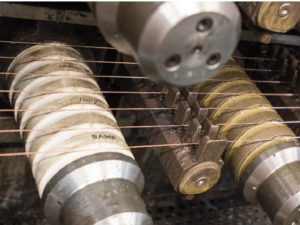Why are Zirconia Drawing Rings and Rolls Yellow? Does it Matter if They are White or Yellow?
Yellow magnesia partially stabilized zirconia (MgPSZ) is typically manufactured from fused zirconia (ZrO2) that is made by melting the material in an arc-melting furnace at ~2700°C. After cooling, it is crushed and classified. The zirconia raw material contains inherent impurities including iron before melting and likely picks up other impurities after melting during crushing/screening operations. The iron impurity creates the yellow color. Producers of MgPSZ using this fused material mix it with magnesia (MgO) or an MgO precursor such as MgCO3. The mix then is processed into MgPSZ.
The major difference between yellow and white is the ZrO2 starting material. White MgPSZ uses purified ZrO2. It too is blended with MgO followed by calcining, milling, spray drying, pressing and firing to make MgPSZ.
To reiterate, the color is an indicator of its purity, but in and of itself does not tell you about the quality or performance in demanding applications like wire drawing.

If Color Doesn’t Matter then What Does?
The raw materials (chemistry & size), forming technique, and firing cycle impact the microstructure to create critical ceramic properties like strength, hardness, toughness as well as wear and corrosion resistance. Density can be used as a non-destructive indicator but in reality small differences generally will not impact performance either.
In comparing properly manufactured toughened zirconias it is important to look at the hardness and the microstructure. Strength is important to some extent, but generally speaking properly made toughened zirconias will be strong enough. The hardness and the microstructure (grain size along with size and volume of pores) are very important and have a direct impact on wear resistance, which is at the heart of capstan performance in wire drawing.
Introducing Izory® HD
When Refractron’s scientists developed Izory® HD they set a new benchmark for toughened magnesia stabilized zirconia (MgPSZ, or TTZ) ceramic properties. Izory® HD has an improved microstructure which translates into a 15% increase in hardness (HV1) and a 40% improvement in standardized abrasion testing. All this without giving up any fracture toughness which is so critical to its durability in manufacturing and use.
Once the ceramic properties are set the performance is also impacted by the precision and accuracy of the grinding used to transform it into a ring or roll, along with the polish on the surfaces in contact with the wire. Refractron uses rigorous quality standards to monitor the ceramic properties established for Izory® HD and uses 100% inspection to ensure dimensions and surface finish requirements are met on every drawing roll or ring. Those inspection records can be traced to the on-site made material with a unique number laser marked on each part.
